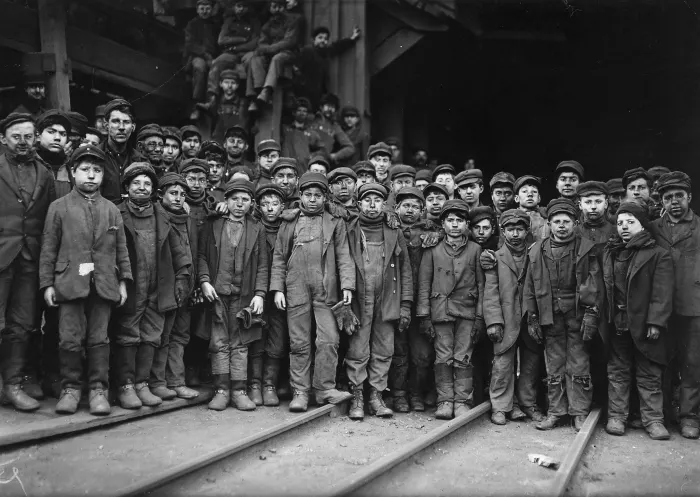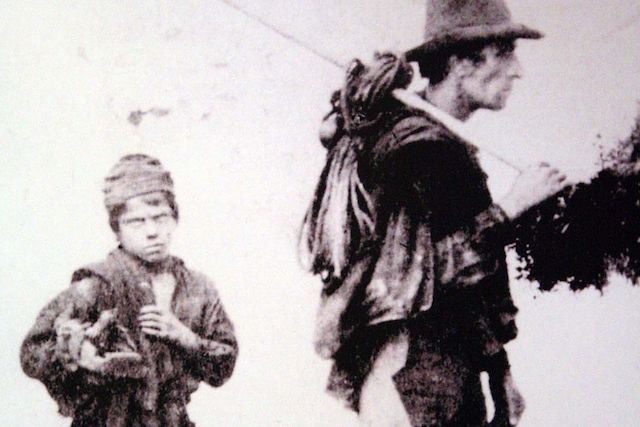
A group of apprentice chimney sweeps. These boys probably all worked for the master chimney sweep in the upper left corner. He is also very short, indicating that he was probably an apprentice as a child, too.
Claire Moores
Our speaker, Claire Moores, was first introduced to the subject of chimneys in her day job with the Fire Service. It wasn’t all about child labour. She started by describing the evolution of the chimney from the simple hole in the roof in the twelfth century which gave vent to smoke coming from a fire in the middle of a space. At first they were built of stone like the rest of the house but the weight of multiple stone chimneys on a roof became too great so the builders began to use brick. By the 1600s most houses would be built around a cen Cross-section of a seven-flue stack in a four-story house with cellars. An 1834 illustration from Mechanics’ Magazine. tral stack, large enough to support four chimneys and these became more and more ornate. However, the imposition of a hearth tax in 1666 proved a significant damper to this desire for more chimneys.
Cross-section of a seven-flue stack in a four-story house with cellars. An 1834 illustration from Mechanics’ Magazine. tral stack, large enough to support four chimneys and these became more and more ornate. However, the imposition of a hearth tax in 1666 proved a significant damper to this desire for more chimneys.
Unfortunately several trends led to the increasing use of ‘climbing boys’. Cities were becoming more crowded, the chimneys were made smaller and narrower to create a better draught and coal was rapidly replacing wood as the fuel of choice by the late 1700s. In earlier times it had been possible to sweep the soot produced by log fires by someone standing in the hearth with an extendable brush. Coal fires produced a different soot that stuck more quickly to the insides of chimneys and built up at the twists and turns in the flues. It deposited a layer of flammable creosote and caked it with soot. Brushing was not satisfactory; in many places the deposit had to be scraped off. As a result young boys were used more and more. Many were as young as four or five and they worked long hours, cleaning as many as eight chimneys each day. They came from foundling homes, orphanages and even direct from impoverished parents. The boys often ‘buffed it’ - climbing naked in the confined space and propelling themselves with knees and elbows.
There was a half-hearted attempt to regulate this work with an Act in 1788 making the minimum age eight years old and that they should have the same treatment as other apprentices but there were no regulatory checks to enforce this and the Master Sweepers paid little attention to it. The abuses continued and occasionally coroner’s reported horrific instances of suffocation, burns, accidents and deaths but few ended in prosecution or even criticism.
Gradually public awareness increased and in 1803 a society was formed to combat this abuse. They not only tried to alleviate suffering but actively sought new ways to clean chimneys without using boys. A winning design produced an extendable brush which could be pushed up a chimney then dragged down again, bring most of the soot with it; very similar to the tools used to this day. A bill was introduced to Parliament but it was defeated on numerous grounds, principally cost and efficiency. It was introduced twice more but on each occasion was defeated. An Act in 1840 made it illegal for anyone under the age of 21 to sweep chimneys but this was widely ignored. Despite attempts to revisit this in 1852 and 1853 no progress was made. However, the movement for reform was gradually building up, one of its most influential leaders was Anthony Ashley-Coper. The 7th Earl of Shaftesbury. Also known as ‘the poor man’s earl’ he had built up a formidable reputation as a social reformer in a wide range of fields - General working conditions, lunacy laws, education and, a particular interest, the limitation of child labour.

Other legislation gradually curbed the worst abuses in both the cotton industry and in coal mining. Some of these regulations applied to climbing boys but were generally ignored. Whereas cotton mills and coal mines were usually larger and more capitalised industries, chimney sweeping was dominated by small enterprises which were much harder to police and to the great shame of society it was not until 1875 that strict requirements were brought in to regulate employment. This finally brought to an end the obscene practise and not before time. It had taken almost a century of half-hearted legislation to bring this about. A very moving aspect of our history which Claire brought to prominence.
Neil Mullineux - January 2024
Further reading:- Child Chimney Sweeps: Dark Chapter in Sweep History

